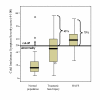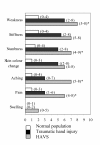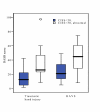Self-reported cold sensitivity in normal subjects and in patients with traumatic hand injuries or hand-arm vibration syndrome
- PMID: 20462418
- PMCID: PMC2881018
- DOI: 10.1186/1471-2474-11-89
Self-reported cold sensitivity in normal subjects and in patients with traumatic hand injuries or hand-arm vibration syndrome
Abstract
Background: Cold sensitivity is a common and disabling complaint following hand injuries. The main purpose of this study was to describe self-reported consequences of cold sensitivity and the association with disability and health-related quality of life in patients with hand injuries or hand-arm vibration syndrome (HAVS) and in normal subjects.
Methods: Responses to the Cold Intolerance Symptom Severity (CISS) questionnaire, Potential Work Exposure Scale (PWES), Disability of the Arm, Shoulder and Hand (DASH) and Short-Form 36 questionnaire (SF-36) were investigated in normal subjects (n = 94), hand injured patients (amputation and nerve injuries, n = 88) and patients with HAVS (n = 30). The results are presented as median (range), percent and mean deviation from norms. The Kruskal Wallis Test or Mann-Whitney U-Test were used to identify significant differences between multiple groups or subgroups. The Spearman rank correlation was used to study the relationship between cold sensitivity and disability.
Results: Abnormal cold sensitivity (CISS score > 50) was seen in 75% and 45% of patients with HAVS and a traumatic hand injury, respectively. Patients were significantly more exposed to cold in their work environment than the normal population, with a consequently negative effect on work ability due to cold sensitivity. Patients with abnormal cold sensitivity were more seriously disabled and had a poorer health-related quality of life than patients with normal cold sensitivity [higher DASH scores and e.g. significantly larger mean deviation from norms in the subscales Role Physical and Bodily Pain (SF-36)].
Conclusion: Severe and abnormal cold sensitivity may have a profound impact on work capacity, leisure, disability and health-related quality of life. It is frequently seen in patients with traumatic hand injuries and particularly apparent in patients with HAVS.
Figures




References
-
- Kay S. Venous occlusion plethysmography in patients with cold related symptoms after digital salvage procedures. J Hand Surg [Br] 1985;10(2):151–154. - PubMed
-
- Irwin MS, Gilbert SE, Terenghi G, Smith RW, Green CJ. Cold intolerance following peripheral nerve injury. Natural history and factors predicting severity of symptoms. J Hand Surg [Br] 1997;22(3):308–316. - PubMed
-
- Lithell M, Backman C, Nystrom A. Pattern recognition in post-traumatic cold intolerance. J Hand Surg [Br] 1997;22(6):783–787. - PubMed
Publication types
MeSH terms
LinkOut - more resources
Full Text Sources
Medical

